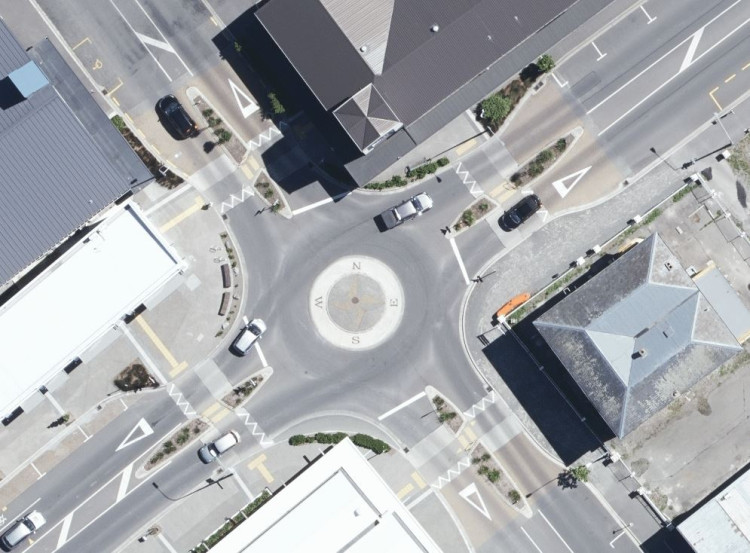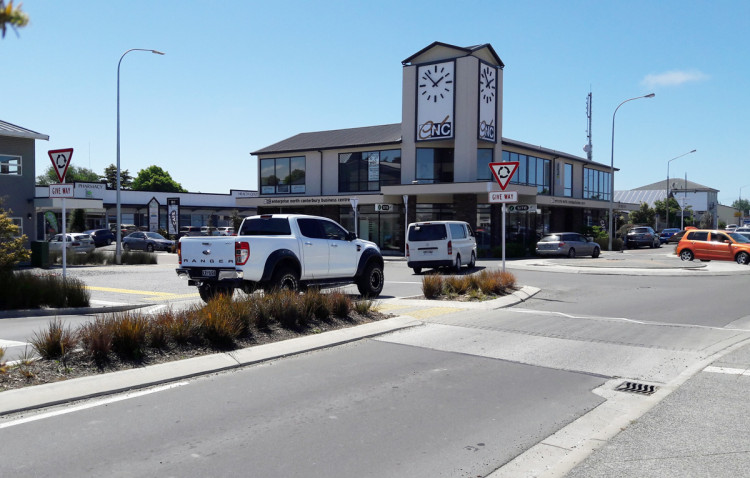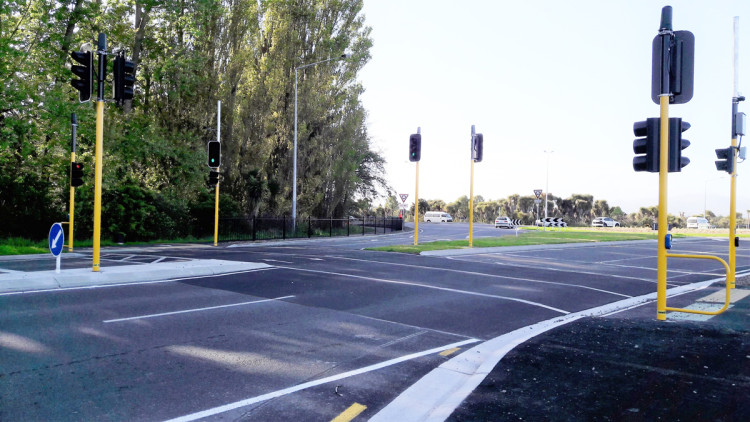Roundabouts are controlled intersections with one or more marked traffic lanes, all of which are for the use of vehicles travelling in a clockwise direction around a central island. They work well for motor vehicles if their volumes on all legs are about equal.
Conversion of give-way or stop controlled local road intersections to roundabouts is often undertaken to address safety issues. Doing so can also reduce pedestrian level of service by requiring pedestrians to move from their desire line to use the designated crossings setback from the roundabout.

Roundabout with pedestrian refuges and zebra crossings, Hataitai, Wellington. (Photo: Ann-Marie Head)
Although treatments can be provided for pedestrians and people cycling at roundabouts, they may not be the most appropriate intersection treatment at locations where there are high levels of cycle and pedestrian volumes and alternative treatments should be considered. Compared to signalised intersections roundabouts can present a significant impediment to pedestrian movement, particularly larger roundabouts with high volumes or speeds of motor vehicles. In such cases it may be very difficult for mobility impaired pedestrians in particular to find an acceptable gap to cross at the roundabout. Furthermore, some vision impaired people find roundabouts particularly difficult to negotiate owing to confusing audible information from cars approaching and exiting the roundabout. This means some vision impaired pedestrians prefer to cross midblock away from the roundabout. It is recommended to ensure there are alternative midblock crossing facilities upstream of the roundabout approaches.
Compact roundabouts with slow vehicle speeds and refuge islands or zebra crossings to assist pedestrians to cross can be appropriate in some contexts.
Cycling Network Guidance: Compact roundabout design
Roundabouts have the following benefits and implications for pedestrians crossing.
Section 10.4 of the Traffic Control Devices Rule 2004 outlines the marking and signage requirements for roundabouts. This section also includes requirements for roundabout metering signals and lane marking for multi-lane roundabouts.
Land Transport Rule: Traffic Control Devices 2004
The following should be considered in the design of roundabouts to assist pedestrians:
Besides tight entry/exit curvatures, vehicle speeds at roundabouts can be further reduced with vertical deflection devices on each approach. These can also function as pedestrian platforms if vertical deflection is applied at the crossing location, as shown below.

Roundabout with pedestrian platforms on all approaches. (Source: Canterbury Maps)
Alternatively the whole roundabout can be raised to slow vehicles and make the crossings for pedestrians more visible as shown in the typical layout in Figure 13-3 of the TCD Manual Part 4.
TCD Manual Part 4 (draft for consultation)
It is best to aim for consistency in the crossing type across all legs of a roundabout. However, differences in vehicle volumes, speeds and pedestrian demand or type may lead to different facility types being more appropriate across one or more legs.
The provision of refuges in roundabout splitter islands will facilitate multi-stage crossing. Splitter islands should be as large as the site allows and should always provide sufficient space for pedestrians to wait, with cut-throughs designed similar to pedestrian islands. Ideally the crossing should be 6m back from the limit line so it is not blocked by queued vehicles. The refuge can be integrated with a pedestrian platform as shown below.
PNG: Crossings (refuge islands)

Raised platform crossing operating as a pedestrian platform, Kaiapoi. (Photo: Jeanette Ward)
Zebra crossings may be installed near roundabouts. There is no required setback from the intersection however, providing a setback of one vehicle between the zebra crossing and the limit line means a vehicle stopped at the roundabout limit line will not block the crossing. Zebras at roundabouts can be raised on platforms, this is recommended to reduce speeds and improve the awareness of the crossing.
There are also signs and marking matters to consider in TCD Manual Part 4 Section 5.5.1. The entire length of the pedestrian crossing must be visible to approaching drivers.
TCD Manual Part 4 (draft for consultation)
Some roundabouts may have high pedestrian volumes and to assist pedestrians to cross (for example, a multilane roundabout) signals may be an appropriate crossing option. To reduce the likelihood of a driver mistakenly thinking the green signal gives them priority to enter a roundabout, where a signalised pedestrian crossing is provided on the approach, the limit line for the signalised crossing and the limit line for the roundabout must be at least 30m apart. This may mean pedestrians are diverted off their desire line which is not desirable and should be minimised. Signalised pedestrian crossings at roundabouts also act as a form of roundabout metering.
TCD Manual Part 4 (draft for consultation)
An example of a signalised crossing for pedestrians and people cycling at a roundabout is shown below. A new high school (2,500 students) was built less than 1km from the school and that increased demand on one of the roundabout legs.

Multilane roundabout with pedestrian signals on north leg. (Source: Canterbury Maps)

Signalised pedestrian/cycle crossing on Frosts Road approach to Travis Road roundabout. (Photo: Jeanette Ward)
[1] Corben, B. (2020) Integrating Safe System with Movement and Place for Vulnerable Road Users, AP-R611-20, p19